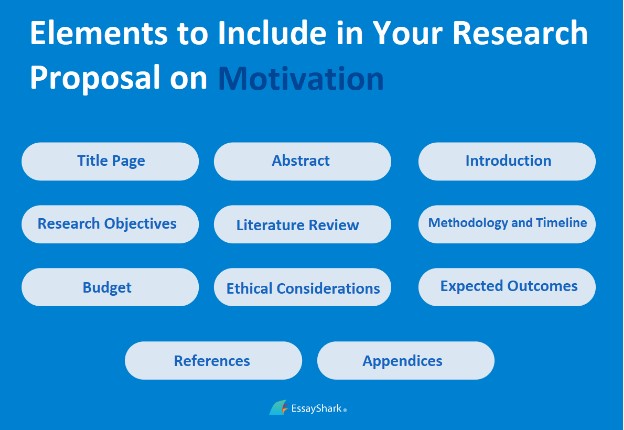Every kind of scientific research, whether it’s a dissertation, an article, a thesis, or a term paper, requires a research proposal. You can’t do without it because it describes the research methods that you are going to use for your project. It is worth noting that this point is quite difficult for not only beginners but also for serious scientists.
What topic should you choose for a research proposal on motivation? Our writing prompts generator will help you with this. How should you write your research proposal? This is a broader question, the answer to which you will find below. Also, don’t forget that our research proposal writing service is here to help you at any stage of writing.
Ready to go?
Table of contents
What Is a Research Proposal?
A research proposal is a structured document outlining your planned study on a specific topic. By the way, on our website, you can find lists of different themes from which you can choose. For example, you can check out our topics on depression. It describes what you’ll investigate, how you will conduct your research, and why it’s worth researching (its significance to the academic community).
In plain English, it’s a detailed plan for your future research.
Whether it’s a research proposal on motivation or any other field, this document allows you to present your ideas to a committee when seeking grant funding or approval for your research project. Given its heavy structure and time-consuming nature, some scholars pay for a research paper to get a complete draft and focus more on defending it to the university board.
Purpose
A research proposal aims at presenting your plan for the scientific investigation you intend to conduct. You need this document to either get funding for the research or get it approved by your supervisor so that you can move forward and do it.
In some cases, it’s a part of your graduate school application.
You write a research proposal to:
- Demonstrate the relevance of your project (showing that it’s original and significant to the academic community).
- Provide context so that the committee sees that you understand the topic, are familiar with the current state of research on it, and know the field.
- Show that you have a methodology (you’ve thought about the tools and procedures needed to conduct your research).
- Confirm that you can complete the project within your funding limits and deadlines.
The difference between a research proposal and a research plan:
In short, it’s the audience. Whereas you write a research plan to organize your thoughts and ensure that you remember all the details, a research proposal convinces others that your work is worth conducting.
Structure
A proposal includes numerous elements, but you can still handle them. First and foremost, state your research problem and explain its significance to the field. Review the existing literature on the topic so that the committee can see that your study is within the context.
Then, outline your methodology: How do you plan to conduct the research?
Support it with a theoretical framework of your approach, a timeline, and the budget required for the study. Specify potential implications and expected outcomes, clearly communicating your research’s objectives and significance.
(When it’s ready, you might want to scan it using an AI essay checker to ensure that it’s sufficiently original and comprehensive. Don’t forget to check all papers you write for generative content.)
Length
How long should a research proposal be?
The length of your research proposal depends on the university guidelines, the field of study, and the academic level you get. So, always check with your institution before you start planning a proposal.
Some universities are okay with a rough outline, while others require a detailed proposal showcasing the first several chapters of your future thesis or dissertation. In general, Masters-level proposals are between 2,000-3,000 words, while PhD-level ones are more detailed, ranging from 5,000-8,000 words.
Your Research Proposal: Elements to Include

How do you format a research proposal on motivation if you are unwilling to buy research paper online?
Provide a structured outline of your future work, including the following elements:
- A title page, with your research paper’s heading, your name, and your affiliations
- An abstract, summarizing your proposal and highlighting your research problem, methodology, and potential impact
- An introduction, overviewing the problem and its significance
- Research objectives
- A literature review, contextualizing your research within the existing works on the topic
- Methodology and a timeline, outlining your research methods and providing an estimated schedule for it
- A budget, outlining the expected cost (if any)
- Ethical considerations, addressing any issues you may have during the research
- Expected outcomes and contributions, also explaining their potential impact
- References, aka the list of sources you’ll use
- Appendices, i.e., any materials supporting your research
| Extra reading: Check out our guide on how to write an essay in APA format to discover all the specifics of academic paper formatting. It will help you avoid tiny mistakes that influence a committee’s final decision on your research. |
Steps to Create a Research Proposal on Motivation
Writing a research proposal on motivation requires self-discipline, time management, and skills in crafting a coherent and comprehensive project presentation.
Keep reading to find a detailed description of what to include in every element of your research proposal.
#1. Title Page
Choose a concise yet descriptive title for your research; make it relevant to your topic yet intriguing enough to evoke curiosity in academics so that they keep investigating your work. If you have problems with that, use our title generator for essay writing. It will help you to come up with an interesting title.
Format a separate title page to introduce your research project to a committee. Here is what to include:
- Your proposed title
- Your name, institution, and department
- Your supervisor’s name
The content of the title page may vary from institution to institution. Some also require your study’s date (year), and others don’t need the name of your department. The formatting will also vary depending on your citation style (APA, MLA, Chicago, etc.)
The takeaway: Check with your institution’s guidelines before designing a title page for your proposal.
| Extra reading: Learn how to write a book title in an essay and master the formatting tricks for different citation styles. |
#2. Abstract
If your research proposal is long, include an abstract for readers to understand its context. A table of contents will also come in handy, as it helps the audience to navigate your work.
What do you need to mention in a research proposal’s abstract?
- Your research question or problem
- The objectives you plan to achieve
- The methodology you’ll employ
- The expected outcomes
#3. Introduction
This section introduces your topic and emphasizes its relevance and significance to the field. Think of it as the pitch for your research project: Give the necessary context for readers and outline your research question and problem statement.
An introduction should be concise; keep it a few paragraphs long, and include the following information there:
- The target audience for your topic (policymakers, scientists, etc.)
- What the academic community already knows about it
- What is missing
- The new insights your research will contribute to the field
- Why your research is worth doing
#4. Research Objectives
Outline specific and clear objectives aligning with your research question. Ensure that they are well-defined, measurable, and achievable; otherwise, you’ll fail the project. This section of your proposal will help the readers understand the direction of your investigation and what you intend to accomplish.
Also, mind the difference between research aims and research objectives:
| Research aim: |
It’s a broad statement about the general purpose of your research.
Write it in the introduction section of your proposal, at the end of your problem statement Research objective:
It’s more specific.
Objectives indicate the particular ways you’ll solve your research problem.
#5. Literature Review
The literature review is another essential ingredient of a winning research proposal on motivation. It’s your opportunity to synthesize all the existing research related to your aims.
Present a clear discussion of what the existing research says concerning your objectives. How to do that:
- Recap the literature on your topic: Use Google Scholar to find resources, visit your university’s library, check reference lists from journal articles, review related dissertations, etc.
- Catalog and synthesize. (Reference management software can help with that.)
- Outlinethe list of literature you’ll review (chronologically by date or thematically by theme).
- Summarize each and write down how their points relate to the research question you’ll investigate in your work.
Why write a literature review in your research proposal?
Three reasons:
- To show that you know and understand the current state of the research (who said what, how it all fits together, etc.)
- To reveal and demonstrate the gap in the existing research for the readers to see that there’s a need for the investigation that you’re going to be doing (It’s about the justification of your study)
- To inform your research design decisions based on the methodological approaches of previous researchers in your field
#6. Methodology and Timeline
This section describes the overall approach you’ll employ to the research. How will you investigate the problem and answer your research questions?
Here’s what to include:
- Your research type: quantitative or qualitative; original data or source analysis; descriptive or experimental research design
- The subject of your investigation: who or what you’ll study; how you’ll choose them or it; where and when you’ll collect the data
- Research methods you’ll use: experiments, surveys, observation, interviews, etc.
| Extra reading: Be sure to check out our expert guide on how to write a diagnostic essay to see what instructors need to assess your knowledge and writing skills. |
Also, provide a detailed timeline for the audience (your supervisor, committee, etc.) to understand how much time you need to complete the project and what milestones and activities you’ll have during the process.
Break the research into smaller tasks and assign time frames for each. Ensure that you cover every step, from the initial phase to the submission.
Here’s an example of a detailed timeline your research project might have:
| Phase | Objectives | Deadline |
| Preliminary research and literature review |
| September 30 |
| Methodology planning |
| October 21 |
| Collecting data |
| December 17 |
| Data analysis |
| January 31 |
| Writing a research paper draft |
| April 3 |
| Revision |
| May 25 |
#7. Budget
Some guides on the topic call this section of a research proposal “Practicalities.” It can be a few different things which vary from institution to institution, but they are anything related to the practical components of pulling off your research project.
Not every piece of research requires additional resources, but if you are applying for funding, you’ll need to estimate the cost of your project and include it in your proposal.
Identify everything you’ll need for the research: laboratory equipment, specific software, databases, travel costs to go somewhere and collect the data, assistants, etc. This will allow you to determine the required budget.
In your proposal, mention how much money (and what resources) you need, why this cost is necessary, and how you calculated that particular amount.
#8. Ethical Considerations
Are there any potential limitations or ethical considerations for your research project? What can influence its results?
In your proposal, address any issues that may arise during your work on the project and describe the measures you’ll take to maintain ethical standards. These measures include ensuring participants’ privacy, obtaining informed consent, and adhering to data protection regulations.
#9. Expected Outcomes and Contributions
Explain what outcomes or results you expect from your research. What are its potential implications for your field of study? This section is critical to your proposal’s argument because it showcases precisely why your research is necessary.
Emphasize what your research will contribute and why it matters.
Cover the following:
- How your work can challenge existing theories in the field
- The practical value it will provide to the academic community
- How your investigations will build the foundation for future research
- What problems your research results can help to solve
- How others can implement your findings in their settings
| Extra reading: Our complete guide on how to write an argumentative essay will help you decide on which solid claims you’ll use to justify your research and prove its outcomes’ contribution to advancing academic knowledge. |
#10. References (Bibliography)
You need a comprehensive reference list at the end of your research proposal, as it will demonstrate your research skills to a committee. One of those skills in an academic environment is technically correct referencing.
So, make sure you understand the referencing requirements from your institution (APA, Harvard, MLA, you name it) and adhere to this citation style throughout your proposal and in the reference list.
Ensure that your references are 100% on point. Please note that your references aren’t only those you mentioned in the literature review section; they are any resources you referred to throughout your research proposal — in the introduction, your methodological section, and others.
Long story short, ensure a flow of citations throughout your document. It will build a solid reference list in your research proposal.
#11. Appendices
Appendices in a research proposal serve as additional supporting materials for the main text. Here, you can add data tables, questionnaires, survey instruments, interview transcripts, technical specifications, letters of permission, consent forms, and other supplementary information.
Appendices provide your document with further depth, sharing comprehensive details that reviewers can refer to.
Research Proposal: A Sample
For you to better understand the nature of a research proposal on motivation, here is a research proposal sample from our writers. They’ve crafted it for this article, so it’s original and okay to use for inspiration or as a template for your future work:
The Influence and Significance of the Self-Determination Theory (Intrinsic and Extrinsic Motivation) Involvement in Educational Process
Abstract
Motivation is one of the factors, which encourage the person to the commitment of some actions and play a crucial role as the psychological determinant. There is plenty of different theories, which try to explain mechanisms of motivation and its affection on various aspects of life. The Self-determination theory (Intrinsic and Extrinsic motivation) consists of two points of a view on the psychological triggers. The essence of this theory is developed throughout the duality of the psychological determinants, which function as a prompt for the further concernment of a person. This theory has wide applicability regarding an educational process and may serve as a model for practical implementation. The variety of ways of involvement of teaching methods based on the Self-determination theory (Intrinsic and Extrinsic motivation) have not had proper functional usage in the real paradigm of a current educational system. The evaluation of the influence of teaching according to principles of this theoretical approach suppose to show a considerable advancement of student motivation. The specific testing and the student’s rate would provide the coherent results of the practical involvement of the Self-determination theory (Intrinsic and Extrinsic motivation) and create a space for further investigation as well. The analysis of the data within the involvement of psychological approach to the evaluation of student’s results helps to understand the weakness of this particular research and in theory itself.
Introduction
The motivation composes a critical aspect of the successful completion of any activity. And the importance of the proper application of methods which are aimed to advance the motivational level of students plays a key role in the entire pattern of an educational process. For the centuries professors and psychologists discussed the advantages and possible ways of realization of different theoretical approaches in the frames of a current educational system. Before the discussion of the influence of particular models of motivational advancement, it is necessary to understand the importance of motivation itself. Motivation composes a considerable significance to an individual as a psychological phenomenon. Exactly due to the motivation person can commit some action, such an approach to the evaluation of motivation is called the self-determinative. Another important point here consists of the variety of theoretical approaches, which are aimed to describe and evaluate distinct motivational paradigms.
The matter here is that the appearance of motivation is a complicated process, which could be realized within external triggers and inner intentions of an individual. Each professor is able to find a personal approach to students and advance their motivational level by some other means. However, the Self-determination theory (Intrinsic and Extrinsic motivation) is one of the most applicable to the pattern of an educational process. As it was mentioned before, the motivation is possible to treat ambivalently, as an inner paradigm and as a suite of different outside influences. The application of such a theory in the pattern of an educational process would help to understand its practical meaning and possible ways of further investigation. The analysis of results would show the functional significance of this approach and contributes to defining perspectives for the entire educational system.
Literature review
Before the evaluation of the background knowledge about the Self-determination theory (Intrinsic and Extrinsic motivation) into the pattern of an education system, it is necessary to understand the entire scope of importance of this aspect into the attitude of students towards education. As it was mentioned before, the motivation is a very complicated phenomenon, which is necessary to analyze from two different sides at once. According to Ames “A qualitative approach to student motivation is concerned with how students think about themselves in relation to learning activities and to the process of learning itself. The salience of specific goals in classroom structures can orient students toward qualitatively different patterns.”(268) So to say, the motivation of students compose one of the most important aspects of a successful educational process.
Discussing self-determination as the main theory in the paradigm of development of motivation. As it was mentioned before, the affection on the motivation could be caused by some internal or some external factors. The self-determination theory claims that Intrinsic and Extrinsic component together create the motivation in the form, which is appropriate to whatever activity. This concept is developed exactly from the different types of emotional and psychological triggers, which may appear during some activity. Ryan and Deci in their work underline the differences between two main types of motivation, which, as the result of their balance, help to develop the collective self-determination motivation of a person towards some particular activity or process (55). This conception has critical importance regarding involvement in the educational system. Frequently, self-determination could serve as the single argument for the student in the decision-making about school performance. That is why the proper pattern of a correlation and successful involvement of some models of teaching has a critical role in the motivation of students.
The discussion of practical importance of the self-determination theory implementation in a standard educational process paradigm should be based on the balanced corporation of Intrinsic (personal attitude towards the activity, the individualistic desire to active performance, etc.) and Extrinsic (the specific combination of incentives and triggers, which are aimed to affect the person and advance personal motivation) motivation. The investigation provided by Noels et al. has a practical character. It had more linguistic nature and was developed with the aim to describe the correlation between the teacher’s working attitude and the further context of a student’s course performance. Even with a distinct principal purpose, this research could serve as the excellent theoretical base for the investigation of the Self-determination theory (Intrinsic and Extrinsic motivation) impact into the pattern of an education system. The matter here is that the motivation has a variation character and the result of the Extrinsic motivation affection on a student is possible to observe in different ways.
Also, the full description of possible perspectives of the Self-Determination theory concerning current educational system was discussed in work by Deci, Edward et al., where the authors described the method in different ways, discussing it as a factor of a behavioral regulator, aspects of some human needs, etc. Also, the authors provide an evaluative analysis of various works based on motivation and its impact on the educational process. According to the authors, there is a considerable difference between results of students, who possess proper amount of Intrinsic motivation and continually obtained the outside influence, which formed the stable Extrinsic motivation, comparing to students, who did not have such specific approach towards their motivation. Such paradigm of research, which had Deci, Edward et al. is based on the belief of several recent decades about the considerable impact of external motivation on the development of self-determination and formation of a concernment in some process as well. The authors underline, that the self-determinative theory “…supports for competence (e.g., optimal challenges and performance feedback) and relatedness (e.g., parental involvement and peer acceptance) facilitate motivation. However, such supports will facilitate intrinsic motivation and integrated internalization only to the extent that autonomy-supportive rather than controlling interpersonal contexts accompany them” (333). On the other words, there is a close connection between Intrinsic and Extrinsic motivation. The matter here is that the previous paradigms of student’s inducement partly had a mistaken character.
The correlation between inside and outside triggers in very high, it is possible to trace the entire pattern of such connection in the experiments of different authors mentioned above. That is why the educational system should pay considerable attention to the various approaches to the personal involvement of students in the educational process. The problem of low rate and performance level among students is possible to fix within the means of particular changes in the theoretical approach of teaching itself. The studies by Deci, Edward et al. and Ryan and Deci could serve as the excellent example of the practical application of different approaches developed on the based of the Self-determination theory (Intrinsic and Extrinsic motivation).
Method
Taking into the account the research question and the background information mentioned above, it is possible to suppose the most appropriate method of the investigation here as qualitative. Regarding current education system, there is a need to provide a practical evaluation of a self-determinative motivational theory affection on students performance in the result of particular outside triggers, which should stimulate the development of an individual concernment of a student in the rate and personal advancement as well.
Before the practical study itself, it is possible to apply The Motivated Strategies for Learning Questionnaire (MSLQ) developed by Duncan and McKeachie, which always provides a correct and coherent statistical information (119). The next step should consist of a division of student into two groups: one, which should obtain the additional motivational triggers from the outside (including a specific atmosphere during the classes, professor’s performance, etc.) and the second group should continue the stable pattern of courses teaching.
After the space of a year of the practical involvement of experiment paradigm, it is necessary to provide The Motivated Strategies for Learning Questionnaire (MSLQ) developed by Duncan and McKeachie one again (119). The results of both tests should be compared and correlated with the rate of every particular student in each experimental group.
Results
The results of this study would show a considerable difference between two groups participated in the study. According to the background information and the research question, discussed above, it is possible to suppose positive changes in the attitude of the first group of students towards their educational performance and considerable advancement of student’s rate, comparing to the second group of students. The analysis of tests, rate and the general level of well being of students would show a substantial practical effect of the Self-determination theory (Intrinsic and Extrinsic motivation) in the pattern of an educational system.
Discussion
It is hard to deny the importance of motivation in the pattern of an educational process. But at the same time, the question of involvement of different motivational theories in reality of a current educational system is investigated poorly. This practical study would contribute to the general paradigm of changes, which should be realized in the further educational reforms. There is plenty of different approaches for a motivation advancement in the frames of the current education system. However, the importance of the Self-determination theory (Intrinsic and Extrinsic motivation) has not many practical pieces of evidence. The matter here is, that the great number of psychologists, for example, Deci and Ryan in their works underline the functional advantage of the Self-determination theory (Intrinsic and Extrinsic motivation) comparing to the other motivational theories. That is why it is possible to suppose this research as a significant contribution to the psychological view of the paradigm of the further development of an educational system.
The matter here is, that, as other practical investigations, this one contains some number of weaknesses, which is necessary to take into the account during the analysis of result and the evaluation of the practical importance of the study itself. The limitations in participants number might cause the weaknesses. Also, there is a chance of issues related to the time limitations. So to say, the time limit may appear as too short for the arriving of any results, which would satisfy the requirements of the research question. These factors and some others require additional improvement in the further investigations, based on this research. That is why the following development of this study is obvious and should be provided with the necessary changes, which would be determined according to the weaknesses of this particular investigation.
Works Cited
Ames, Carole. “Classrooms: Goals, Structures, and Student Motivation.” Journal of Educational Psychology, vol 84, no. 3, 1992, pp. 261-271. American Psychological Association (APA), doi:10.1037/0022-0663.84.3.261.
Deci, Edward L. et al. “Motivation and Education: The Self-Determination Perspective.” Educational Psychologist, vol 26, no. 3-4, 1991, pp. 325-346. Informa UK Limited, doi:10.1080/00461520.1991.9653137.
Deci, Edward L., and Richard M. Ryan. “Self-Determination.” The Corsini Encyclopedia of Psychology. John Wiley & Sons, Inc., 2010. Wiley Online Library, doi:10.1002/9780470479216.corpsy0834.
Duncan, Teresa Garcia, and Wilbert J. McKeachie. “The Making of the Motivated Strategies for Learning Questionnaire.” Educational psychologist, 40.2, 2005, pp. 117-128.
Noels, Kimberly A. et al. “Perceptions of Teachers’ Communicative Style and Students’ Intrinsic and Extrinsic Motivation.” The Modern Language Journal, vol. 83, no. 1, 1999, pp. 23-34. Wiley-Blackwell, doi:10.1111/0026-7902.00003.
Ryan, Richard M., and Edward L. Deci. “Intrinsic And Extrinsic Motivations: Classic Definitions and New Directions.” Contemporary Educational Psychology, vol. 25, no. 1, 2000, pp. 54-67. Elsevier BV, doi:10.1006/ceps.1999.1020.
Look another sample motivational speech about negative emotions.
Mistakes to Avoid When Designing Your Research Proposal
When crafting a research proposal on motivation or any other subject, it’s critical to make it specific and concise. It’s formal writing, and the overly broad or flowery descriptions inherent to narrations aren’t acceptable here.
| Extra reading: Check our comprehensive guide on how to write a narrative essay to see the difference. |
Below are the most common pitfalls to avoid when writing a research proposal:
- Wordiness. Keep it brief and to the point
- The absence of a strong argument for your research. Make it persuasive so that the audience says “Yes” to your work
- An overly broad research topic. Narrow it down so the reader can see its significance to the academic community
- Including too many issues in your proposal, distracting from its central purpose
- A weak theoretical foundation for your study
- Failing to connect your research problem to existing studies on the subject
- Poorly articulated research aims and methodology
- Failing to plan the research project and manage the risks
- Sloppily presenting your research proposal to a committee
- Failing to follow your university’s specific criteria
Need Help With Your Research Proposal?
Now you know everything you need to know about how to write your research proposal on motivation, starting with its definition and ending with mistakes to avoid. After you finish writing, don’t forget to check your paper for uniqueness. If you see that there are some plagiarized pieces, it is better to use our paraphrasing tool online. With it, you will definitely submit a unique proposal.
And remember:
We have professional research papers for sale (just in case you need help with your own). Feel free to place an order and provide the instructions and deadlines; our writers will gladly assist you!
Photo by RonRatte from Pixabay









